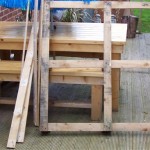We may receive a commission when you use our affiliate links. However, this does not impact our recommendations.
I’ve been surfing various wood forums lately and I’ve seen a pleasing amount of discussion on period furniture. As all of you know, you hear contradictory things on the internet. A recent discussion about 18th c drawer construction still has my head spinning.
Seeing Allan Breed’s recent post, originating from a sapfm forum post made me think about how we learn about period furniture. Breed presents an archeological view of period furniture. I put a lot of stock in that approach. And I wonder how, without the sort of access Allan has and has enjoyed over the years, anyone can be so certain about how furniture was made or even what it looks like.
When we think about archeology we often conjure the image of Howard Carter, digging up treasures in Egypt, and racing them back to the British Museum in the dark of night. Well, if that’s not your image of archeologists, it’s George Lucas’ at least. Of course, that’s not what archeologists do (now). Most spend their time analyzing the field reports of others. So strictly speaking, we who examine period furniture or review the findings of others, are essentially engaging in archeology.
As it applies to us, I include the study of period tools, shops, tool chests, etc as all falling under the archeological umbrella. These various objects contribute to the formation of an historical narrative, created by an informed understanding of the objects, their use, etc. And that last bit, “an informed understanding of the objects…¦” is where I see us coming in. I saw evidence of scratched layout lines on old furniture, and found evidence of period layout knives. I later found an old layout or striking knife and found it useful in dimly lit shops. So the knife became part of that narrative that I used to suggest a way of working to scribed lines. That narrative informed my sense of the use of wooden try squares. Hopefully you know those stories.
The big problem with the archeological approach to learning about period furniture is that so few of us have good access to the artifacts. As you’ll read in the sapfm post linked above, when we encounter period furniture first hand, our impressions of it often change.
We face the additional challenge that there are few really good field reports. Auction or museum catalogs are often poor sources of detailed information about construction. Their aim is typically to elucidate art history and they can be VERY good for that. But I’ve seen photos of pieces in the Philadelphia Art Museum where the photos almost look doctored. The originals just don’t look that good in person. In my mind, this makes the observations of Peter Follansbee, Allan Breed, or Mack Headley to name a few all the more helpful.
Long live the furniture archeologists! In my next blog, I’ll take a look at the historical approach. I don’t mean to spoil the ending. Of course we need both approaches. I’ll write more about that next time and I’ll look forward to your comments.
Adam
Here are some supplies and tools we find essential in our everyday work around the shop. We may receive a commission from sales referred by our links; however, we have carefully selected these products for their usefulness and quality.









Thanks Stan. I have seen, if not that video, one very similar to it. When I was a little boy I wanted to grow up to be an American Indian. I never achieved that goal, but I have retained a near insatiable appetite for all things native american.
My Grandfather built a small house on one of New Jersey’s narrow barrier islands. We used to spend our Summers there. I recall Grandpa reading a book to me which now seems prescient. "Dicken Among the Indians" was about a boy ship wrecked on a barrier island in NJ in the mid to late 18th century. The Lenape Indians took him in and in chapter after chapter taught him their ways and their crafts. For me, that book had it all: the wonderful NJ coastline, the 18th century, Indians, and woodcraft with homemade hand tools.
I think the bulk of experimental archeology is being done by folks studying pre-historic cultures (which includes near modern day Native American cultures). Our little woodworking niche almost fits the pre-historic definition!
Adam
Well written and very enjoyable to read Adam. I watched a documentary up here in Canada a few years ago in which a man demonstrated how the traditional Objibway Indians made an entire canoe of birchbark using only a knife with a hook on it. Maybe you saw it too. It gives a new prospective to riving.
I may have copied it so if I can find it, I might be inclined to send you a copy if you are interested.